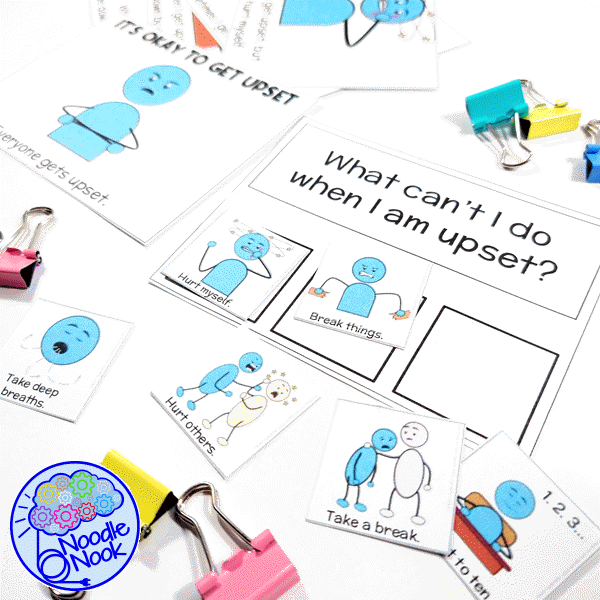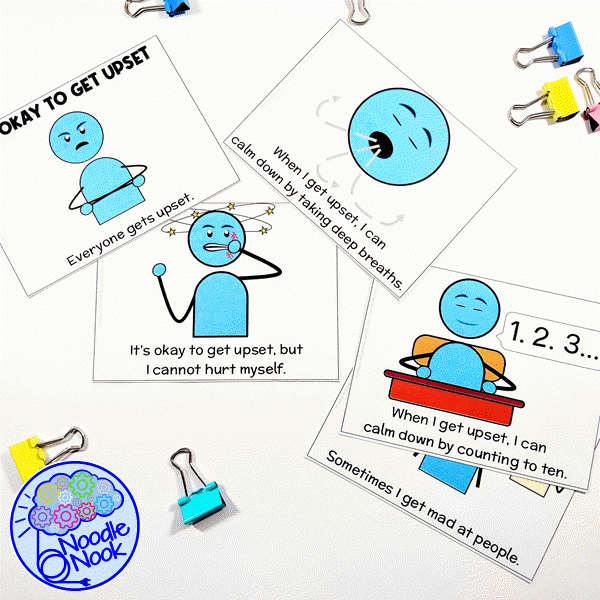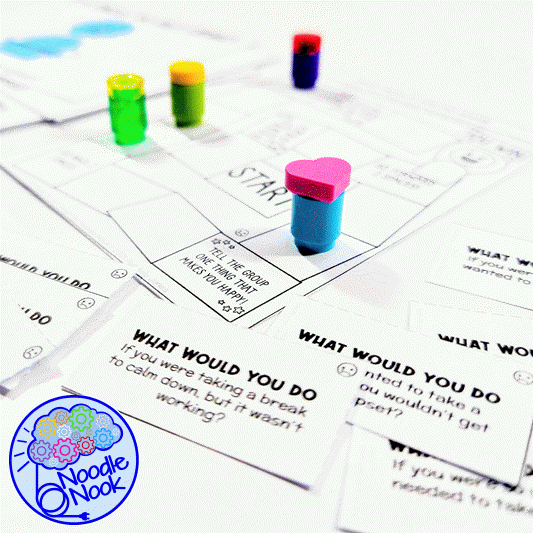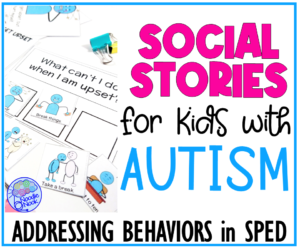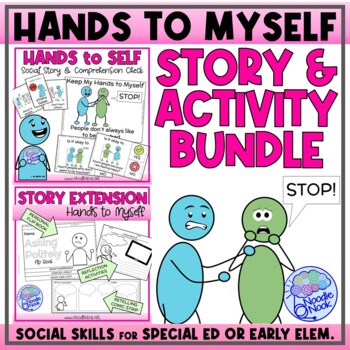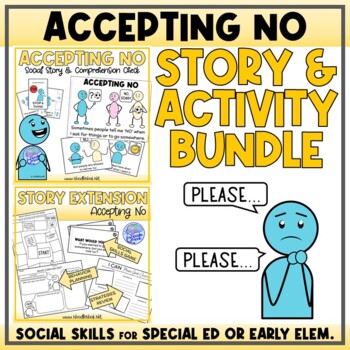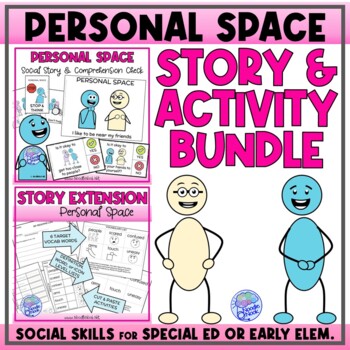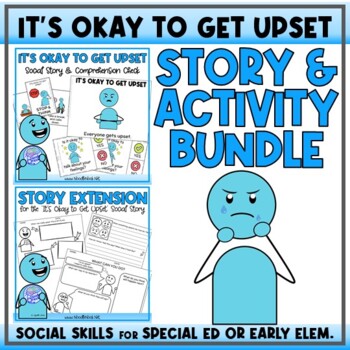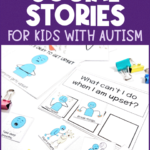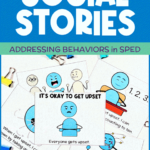Social stories for kids with autism are an absolute special education classroom must-have! Social skill-building resources and instructional activities for behavior in special education classrooms support not only students with autism spectrum disorders but also any student who is learning social norms. For most special needs classrooms, using social narratives or social stories to improve social behaviors is a no-brainer. So, let’s find out more about how social stories can have positive results in the learning experience of students with disabilities, including autism.
P.S. If you’re looking for more information on how to use social stories as well as why they are so important, please check out this post.
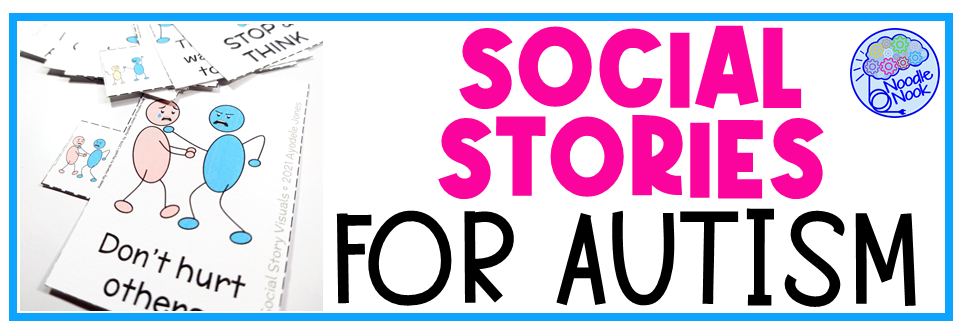
What are Social Stories?
Social stories are short narratives that help children with autism understand social situations and expectations. When they are done right, they provide some affirmative sentences about the child’s feelings. They identify the undesired behavior and then describe the appropriate social behavior or social rules a student should follow. They’re written from the child’s perspective and use simple language, pictures, and examples.
Some of the important things to know about social stories are:
- They can help children with autism learn appropriate behaviors, emotions, and responses in various contexts, such as school, home, or community.
- They can reduce anxiety, confusion, and frustration for children with autism who may struggle with social cues, communication, or transitions.
- They can increase the child’s confidence, self-esteem, and independence by providing clear guidance and positive feedback.
- They can be customized to suit the child’s needs, interests, and abilities, and can be used for different purposes and goals, such as teaching new skills, coping with changes, or preparing for events.
- They can be created by parents, teachers, therapists, or anyone who knows the child well, using online resources, templates, or books.
If you’re trying to improve behavior in a variety of social situations for students with developmental disabilities or autism, then social stories are your tool of choice. They allow you to clearly show the expected behavior in a targeted situation with visual aids and are a great way to improve overall social skills.
What is in a Social Story?
Social stories are short stories that specifically help autistic children and young children understand social situations and expectations. They are written in the present tense and usually in first person. A good social story includes three types of sentences.
- Descriptive sentences provide factual information about the given situation, such as the physical condition, the people involved, and the actions that occur.
- Perspective sentences explain the feelings, thoughts, or motives of other people in the situation, or of the child themselves.
- Directive sentences suggest the desired behavior or response that the child should follow in the situation. This directive sentence is the exact behavior or skill you are looking to improve.
Social stories have become an evidence-based practice and a powerful tool for teaching social skills and communication to autistic children and young people. Social stories can be used for a variety of settings and scenarios, such as school, home, community, or special events. They can help the child cope with new situations, unfamiliar situations, complex situations, or difficult social situations. They can also help the child learn abstract concepts, such as emotions, time, or rules.
What to Look for in a Good Social Story
The goal of the story is to match the child’s needs, interests, and abilities, and to provide a supportive quality that helps the child feel confident and comfortable. The story should use positive language, visual cues, and examples that are relevant and meaningful to the child. The story should also be reviewed and revised regularly, based on the child’s feedback and progress.
I have seen the good and the bad when it comes to social stories.
To create effective social stories or determine if a social story is any good, look for three main elements: replacement behavior, engaging visuals, and a clear message.
REPLACEMENT BEHAVIOR
FIRST, the social story targets specific replacement behavior or strategy. I see some that are just like “It’s nice to be nice”. The problem: what is nice?
The replacement behavior is the specific behavior or strategy that you want the child to learn and use in the social situation. For example, if the child tends to interrupt others during a conversation, the replacement behavior could be raising their hand or waiting for their turn.
The social story should explain why this behavior is important and how it will benefit the child and others. Look for a target phrase, action, or strategy that a student will use in the same situation to manage it in a socially appropriate manner or, at the very least, instead of doing the non-preferred behavior.
ENGAGING VISUALS
SECOND, find stories that have engaging visuals. The student will respond best if they can relate to the story. Visuals are the pictures or illustrations that accompany the text and help the child understand the social situation and the replacement behavior. The visuals should be clear, realistic, and consistent with the child’s experience. For example, if the social story is about going to the dentist, the visuals should show the child’s actual dentist and the dental office. The visuals should also show the child’s emotions and reactions, as well as the emotions and reactions of others in the situation.
BUT, for most teachers, we just don’t have time to individualize a dozen books for a dozen different students, complete with real pictures, lamination, and Velcro. Not feasible. With that in mind, look for graphics that are gender and race-neutral and still engaging and clear.
CLEAR MESSAGE
THIRD, look for text that is clear, concrete, and free from jargon or confusing messaging. Remember, this is about explaining: when to use the strategy, how to use the strategy, what happens when you use the strategy, what happens when you don’t use the strategy, and the nonpreferred target behavior the student should no longer do. That’s a lot to pack into a social story, but without these things, the story will not be as effective.
As you are looking for the most effective social stories for kids with Autism, look for target replacement behaviors, engaging visuals, and a clear story with concrete examples. These criteria will make the social stories or narratives you use in your special education classroom most impactful for students.
As an ADDED BONUS, I also like social stories that have related activities to extend learning. After you’ve read the story a few times, you’ll want to have some vocabulary activities, social skills games, or other comprehension check resources to reinforce the narrative. Some of my favorites are games, cut-and-paste vocabulary, and right-wrong sorts.
Essential Social Stories for Special Ed
If you teach in special education, then there are some social stories for Autism and students with significant disabilities that you’ll find you need over and over again. Even if you don’t teach special ed, some of these stories are winners and must-haves, specifically if you teach elementary-aged students. They will help you teach about social interactions, body language, facial expressions, and more. What’s even better is these targeted story-based interventions can be shared with parents of children, related service providers, and therapists so everyone can approach a difficult social situation with a united front.
Social narratives are effective and helpful, and the most important social learning tool you can have in your classroom. So, if you teach in an Autism unit, self-contained classroom, or just plain ol’ sped, do yourself a favor, and get the entire ultimate set of social stories! When you have just what you need to address any social impairment with the perfect social story! Here are a few social skills stories that you’ll want in your classroom:
Social Stories about Hitting
This is something WAAAAY too many of us special education teachers have to deal with… Keeping your hands to yourself!
The good news is there is a great social story for hitting that focuses on a replacement behavior that isn’t violent.
It centers on a calming sequence instead of hitting or touching others. Click HERE for more.
Social Stories about Lying
Lying is one of those things you end up dealing with no matter WHAT level you teach at. Yup, this should be in your classroom just because.
Just keep it within arms reach prepped and ready to go. If all else fails, use the story and the related activities as your sub plans for that extra-long IEP meeting you have coming up. Click HERE to see more.
Social Stories about Accepting NO
Hey, I don’t like to hear NO either, but for some of our students, dealing with the fallout of not getting what they want is serious.
If this sounds like one of your kiddos, then keep this social story on the ready! Click HERE to see more.
Social Stories about Personal Space
I have a bubble and so do you! Just because we know it doesn’t mean our students always show it.
Teach and reinforce social skills related to personal space.
This is a great one to pair with Keeping Hands to Yourself those first few weeks of school. Click HERE for more.
Social Stories about Anger
Everyone gets upset… but there are some rules when you’re about to lose it, just reference any Avengers movie.
You have a great responsibility because you have great power. Those include not hurting others, yourself, or property when you are upset.
This is a winner (and one of my most referenced books in my classroom) no matter what level you teach. Click HERE to see more.
And more!
I suggest using these in a weekly cycle if you are building in social skills as part of your routine instruction. If you do that, you’ll end up with these big ideas each term or grading period:

